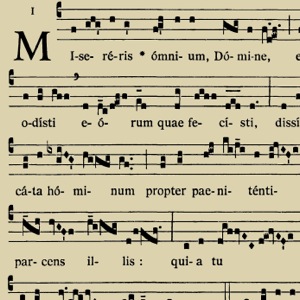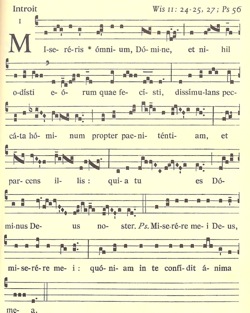
GIRM ~ General Instruction of the Roman Missal
- The main place should be given, all things being equal, to Gregorian chant, as being proper to the Roman Liturgy. Other kinds of sacred music, in particular polyphony, are in no way excluded, provided that they correspond to the spirit of the liturgical action and that they foster the participation of all the faithful. – From the Constitution on the Sacred Liturgy.
Since the faithful from different countries come together ever more frequently, it is desirable that they know how to sing together at least some parts of the Ordinary of the Mass in Latin, especially the Profession of Faith and the Lord’s Prayer, according to the simpler settings.

Sacrosanctum Concilium Constitution on the Sacred Liturgy Promulgated by Pope Saint Paul VI – December 4, 1963
- The musical tradition of the universal Church is a treasure of inestimable value, greater even than that of any other art. The main reason for this pre-eminence is that, as sacred song united to the words, it forms a necessary or integral part of the solemn liturgy.
Holy Scripture, indeed, has bestowed praise upon sacred song, and the same may be said of the fathers of the Church and of the Roman pontiffs who in recent times, led by St. Pius X, have explained more precisely the ministerial function supplied by sacred music in the service of the Lord.
- The treasure of sacred music is to be preserved and fostered with great care.
116. The Church acknowledges Gregorian chant as specially suited to the Roman liturgy: therefore, other things being equal, it should be given pride of place in liturgical services.

Tra Le Sollecitudini ~ Instruction on Sacred Music Motu Propio -November 22, 1903 – Pope Saint Pius X
1 ~ Sacred
2 ~ Beautiful
3 ~ Universal
- Sacred music should consequently possess, in the highest degree, the qualities proper to the liturgy, and in particular sanctity and goodness of form, which will spontaneously produce the final quality of universality.
“It must be true art….”
But it must, at the same time, be universal in the sense that while every nation is permitted to admit into its ecclesiastical compositions those special forms which may be said to constitute its native music, still these forms must be subordinated in such a manner to the general characteristics of sacred music that nobody of any nation may receive an impression other than good on hearing them.

Restoration of Gregorian Chant – Pius X
The ancient traditional Gregorian Chant must, therefore, in a large measure be restored to the functions of public worship, and the fact must be accepted by all that an ecclesiastical function loses none of its solemnity when accompanied by this music alone. Special efforts are to be made to restore the use of the Gregorian Chant by the people, so that the faithful may again take a more active part in the ecclesiastical offices, as was the case in ancient times.
Restoration of Gregorian Chant – Vatican II ~ (Sacrosanctum Concilium)
- The typical edition of the books of Gregorian chant is to be completed; and a more critical edition is to be prepared of those books already published since the restoration by St. Pius X.

What is the “First Option”?
The Entrance
- This chant is sung alternately by the choir and the people or similarly by a cantor and the people, or entirely by the people, or by the choir alone. In the Dioceses of the United States of America, there are four options for the Entrance Chant:
(1) the antiphon from the Missal or the antiphon with its Psalm from the Graduale Romanum, as set to music there or in another setting;
(2) the antiphon and Psalm of the Graduale Simplex for the liturgical time;
(3) a chant from another collection of Psalms and antiphons, approved by the Conference of Bishops or the Diocesan Bishop, including Psalms arranged in responsorial or metrical forms;
(4) another liturgical chant that is suited to the sacred action, the day, or the time of year, similarly approved by the Conference of Bishops or the Diocesan Bishop.
Communion (The gateway for singing the propers!)
- While the Priest is receiving the Sacrament, the Communion Chant is begun, its purpose being to express the spiritual union of the communicants by means of the unity of their voices, to show gladness of heart, and to bring out more clearly the “communitarian” character of the procession to receive the Eucharist. The singing is prolonged for as long as the Sacrament is being administered to the faithful. However, if there is to be a hymn after Communion, the Communion Chant should be ended in a timely manner.
Care should be taken that singers, too, can receive Communion with ease.
- In the Dioceses of the United States of America, there are four options for singing at Communion:
(1) the antiphon from the Missal or the antiphon with its Psalm from the Graduale Romanum, as set to music there or in another musical setting;
(2) the antiphon with Psalm from the Graduale Simplex of the liturgical time;
(3) a chant from another collection of Psalms and antiphons, approved by the Conference of Bishops or the Diocesan Bishop, including Psalms arranged in responsorial or metrical forms;
(4) some other suitable liturgical chant (cf. no. 86) approved by the Conference of Bishops or the Diocesan Bishop. This is sung either by the choir alone or by the choir or a cantor with the people.

Surprise! Musical Hierarchy in “Sing to the Lord: Music in Divine Worship”
1. Dialogues and Acclamations
2. Antiphons and Psalms
“The psalms are poems of praise that are meant, whenever possible, to be sung. The Psalter is the basic songbook of the Liturgy.”
“The Entrance and Communion chants with their psalm verses serve to accompany the two most important processions of the Mass: The Entrance and Communion antiphons are found in their proper place in the Roman Missal. Composers seeking to create vernacular translations of the appointed antiphons and psalms may also draw from the Graduale Romanum, either in their entirety or in shortened refrains for the congregation or choir.
Sing to the Lord: “117. Proper antiphons from the liturgical books are to be esteemed and used especially because they are the very voice of God speaking to us in the Scriptures.”
3. Refrains and Repeated Responses
“The Liturgy also has texts of a litanic character that may be sung as appropriate. These include the Kyrie and Agnus Dei of the Mass, the response to the Prayer of the Faithful at Mass or the intercessions at Morning Prayer and Evening Prayer, and the Litany of the Saints in various rites.”
4. Hymns (and songs)
That hymns are of the lowest priority may come to many as something of a bombshell—no less a surprise!

Pope Saint John Paul II on Gregorian Chant and new compositions
On THE FEAST OF SAINT CECILIA, November 22 2003, Pope Saint John Paul II gave the Chirograph for the Centenary of Tra le sollecitudini of Pope Saint Pius X.
- With regard to compositions of liturgical music, I make my own the “general rule” that St Pius X formulated in these words: “The more closely a composition for church approaches in its movement, inspiration and savour the Gregorian melodic form, the more sacred and liturgical it becomes; and the more out of harmony it is with that supreme model, the less worthy it is of the temple”. It is not, of course, a question of imitating Gregorian chant but rather of ensuring that new compositions are imbued with the same spirit that inspired and little by little came to shape it.
He immediately follows with words extremely humbling for any composer:
“Only an artist who is profoundly steeped in the sensus Ecclesiae can attempt to perceive and express in melody the truth of the Mystery that is celebrated in the Liturgy.”

Free Resources in ENGLISH & LATIN!: Many can be found at www.musicasacra.com and MORE.
- Communio ~ Richard Rice – Chants of the Gradale Romanum – verses written out. Also available with Verses in English!
- Parish Book of Chant ~ Richard Rice
- Gregorian Missal for Sundays ~ in accordance with the Novus Ordo Solesmes *contains English translations
- The Propers of the Mass in English – Organ Accompaniments and modern notation available at this link! , Fr. Samuel F. Weber
- Simple Choral Gradual ~ Richard Rice
- Simple SATB settings
- texts from 1986 Sacramentary
- Simple English Propers ~ Adam Bartlett – Organ Accompaniment and modern notation available at this link! (translated texts from the Graduale Romanum) Published by CMAA
- Communion Antiphons for Ordinary Time ~ Richard J. Clark – Organ accompaniment, cantor, optional SATB.
- Graduale Romanum 1974
- Liber Usualis 1961
- NOVA ORGANI HARMONIA (“NOH”) organ accompaniment scores were created during WWII by faculty members of the Lemmens Institute (Belgium): Flor Peeters, Msgr. Jules Van Nuffel, Msgr. Jules Vyverman, Marinus de Jong, Gustaaf Nees, Henri Durieux, and Edgard de Laet. All 2,279 pages are available for free download as PDF files at Corpus Christi Watershed: www.ccwatershed.org/nova

From World Library Publications:
- Introit Hymns ~ Christophe Tietze ~ World Library Publications
• Hymn Tune Introits: Singing the Sundays of the Liturgical Year – Kathleen Pluth – WLP
Communion Antiphons by Richard J. Clark ~ World Library Publications Antiphon texts from the Roman Missal, Third Edition (Keyboard, Optional SATB, Assembly)
~ Communion Antiphons for Advent
~ Communion Antiphons for the Christmas Season
~ Communion Antiphons for Lent
~ Communion Antiphons for the Easter Season
~ Communion Antiphons for Solemnities & Feasts in Ordinary Time (Vol. 1 out soon! Vol. 2 in 2020.)
~ Communion Antiphons for Ordinary Time???
